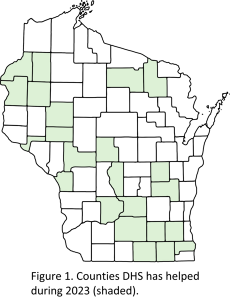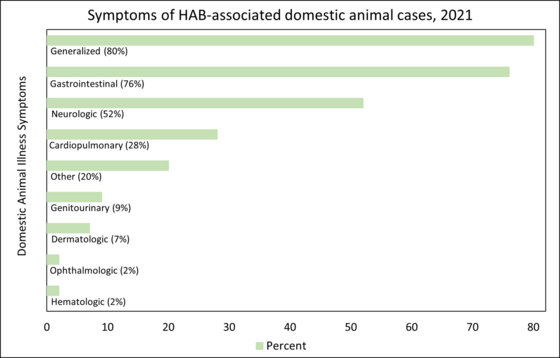
The 2023 Year in Review
2023 was certainly one for the books here at the Wisconsin Department of Health Services. A big thanks to local, state, and federal partners for their contributions to an eventful and successful year. Highlighted below are some of our favorite memories and accomplishments of 2023.

- We received and investigated 29 HAB health complaints, consisting of 26 human and three animal illnesses. After conducting thorough investigations, four human and three dog illnesses were determined to be possible cases of HAB toxicity.
- We assisted 23 counties in Wisconsin. We fielded questions and inquiries from citizens, public and environmental health officials, human and animal medical professionals, the media, and lake association groups across Wisconsin (Figure 1.). We also helped seven other states across the U.S. and Canada.
- We attended seven conferences where we provided technical and high level information related to HABs to diverse audiences.
- We led and facilitated our first ever HAB illness training webinar where local environmental and health professionals learned how to identify, report, and address HAB-related illnesses.
- We wrote and published new epidemiological research. Over the last two years, we worked with federal agencies like the CDC, EPA and NASA, to investigate the relationship between the HAB events and hospital visits for respiratory conditions in the Green Bay area. This study is one of the first to use novel methods to assess this relationship and is one of very few studies to look at respiratory effects of HABs among human populations. Read our article in the International Journal of Hygiene and Environmental Health!
|

The HAB Program's 2024 Resolutions
While we have many big things planned for 2024, one of our main focuses will be on increasing and improving the outreach materials our program offers. These efforts will include:
- Translating our fact sheets to other languages that are spoken throughout Wisconsin like Spanish and Hmong.
- Creating and publishing new outreach materials and resources. Before the 2024 HAB season begins, we plan to produce the following items:
- A HABs and safe fishing and fish consumption fact sheet
- An updated version of our HAB toolkit for public health and emergency response professionals
- A FAQs document for local health departments interested in developing a HAB monitoring program
- Supporting YOU! How can we help meet your HAB-related needs this year? Let us know by emailing dhshabs@dhs.wisconsin.gov.
|
New Research From the CDC
Using a One Health approach, the CDC collects data about HAB events and associated human and animal illnesses through a voluntary reporting database called the One Health Harmful Algal Bloom System (OHHABS). These data are used to increase knowledge about HAB illnesses and inform public health prevention efforts.
The CDC recently came out with a new report that summarizes HABs and health data on a national scale. Featured below are important findings from this report:
- Sixteen states, including Wisconsin, reported 117 human illnesses and 2,715 animal illnesses suspected to be caused by exposure to HABs during 2021.
- About half of the reported human illnesses were among people younger than 18 years old. These data suggest that children and teenagers may be at higher risk of exposure and illness than adults.
- Gastrointestinal symptoms like diarrhea and vomiting were the most frequently reported symptoms among people who became ill (Figure 2.). In domestic animals, vomiting, lethargy, and ataxia (stumbling/loss of balance) were the most common symptoms (Figure 3.).
 Figure 2. Signs and symptoms reported by human illness complainants during 2021 (n=117).
 Figure 3. Signs and symptoms reported in domestic animal illness complainants during 2021 (n=46).
Bats fall victim to blooms.
Most of the animal illnesses reported to OHHABS resulted in deaths. Included in this report was a massive wildlife mortality event involving 2,000 bats that died from a HAB in Washington. This die-off illustrates animals’ susceptibility to HAB toxins and the detrimental effects a single bloom can have on wildlife and the ecosystem.
|
|
 |
 |
|
Lets Get Social! |
It’s not too late to make a New Year’s resolution! Now’s the perfect time to start thinking about how you can keep Wisconsin’s lakes clean and healthy this summer. Learn what you can do to help prevent algal blooms by visiting DHS's HAB website.

Missed a past issue? Previous issues are available on our Resources for Health Professionals webpage.
Email us your burning questions! If others can benefit from hearing the answer to your question, we’ll feature it in a future issue.
Remember that we are always available for consultation on any HAB health-related issue by email or phone (608-266-1120).
|
|